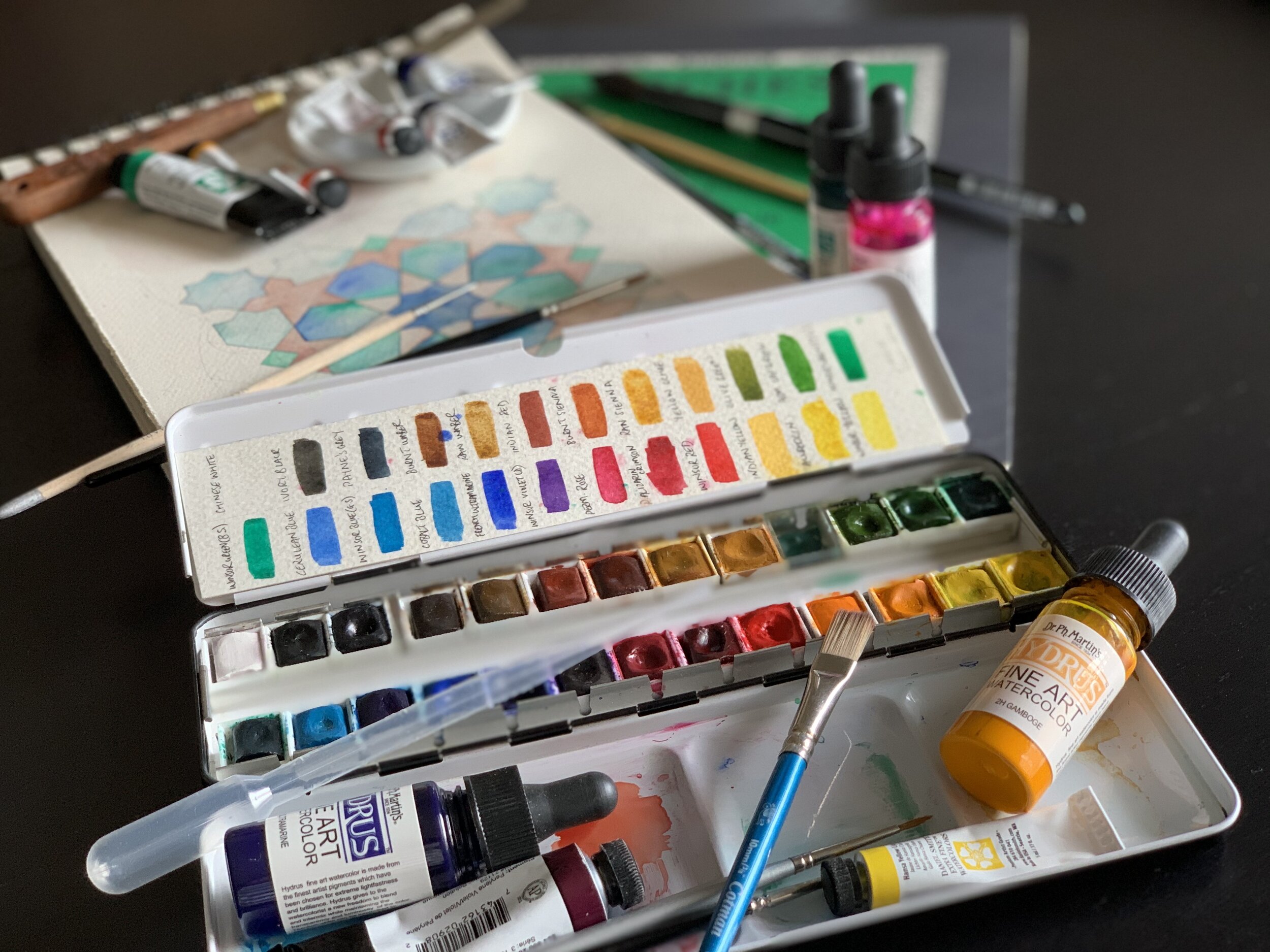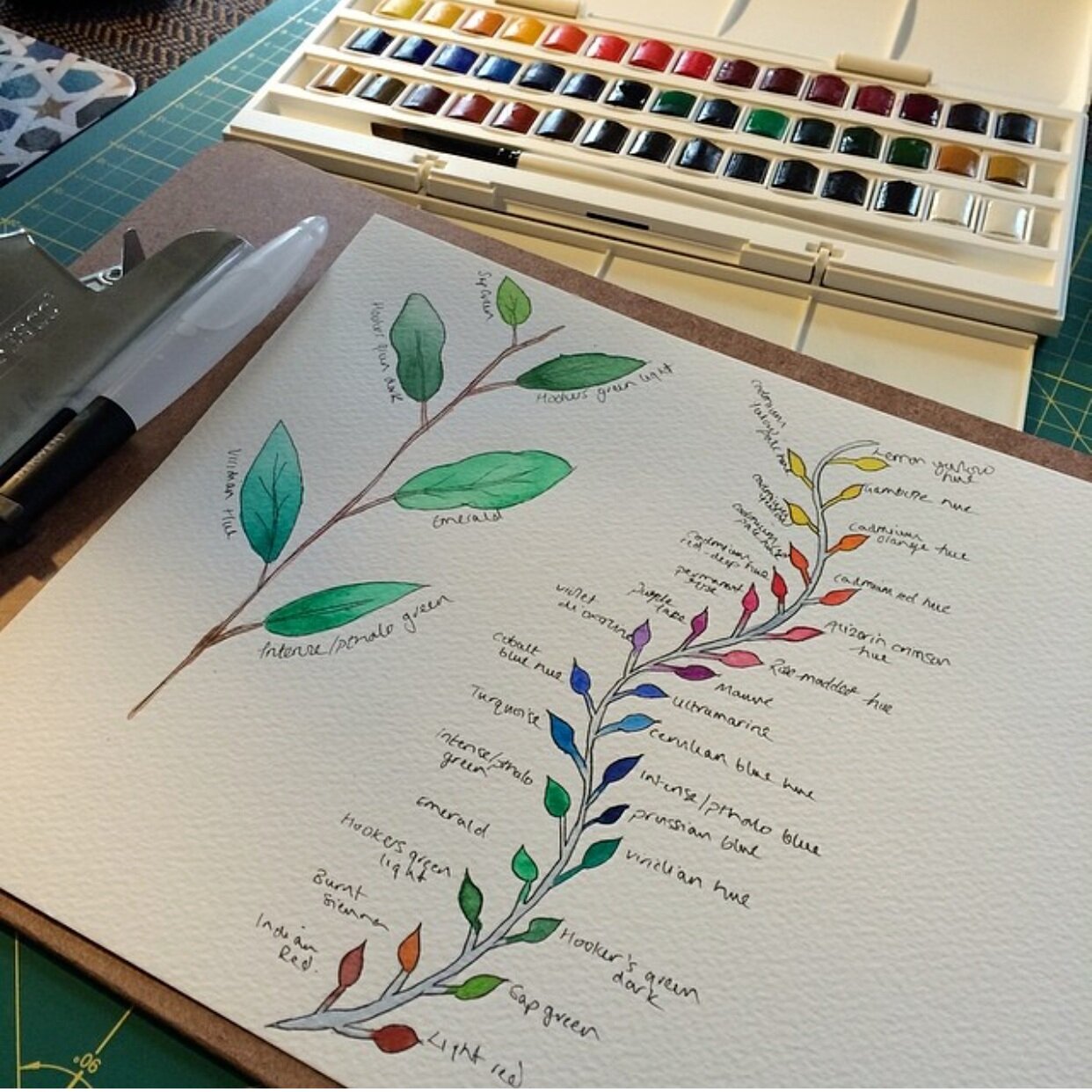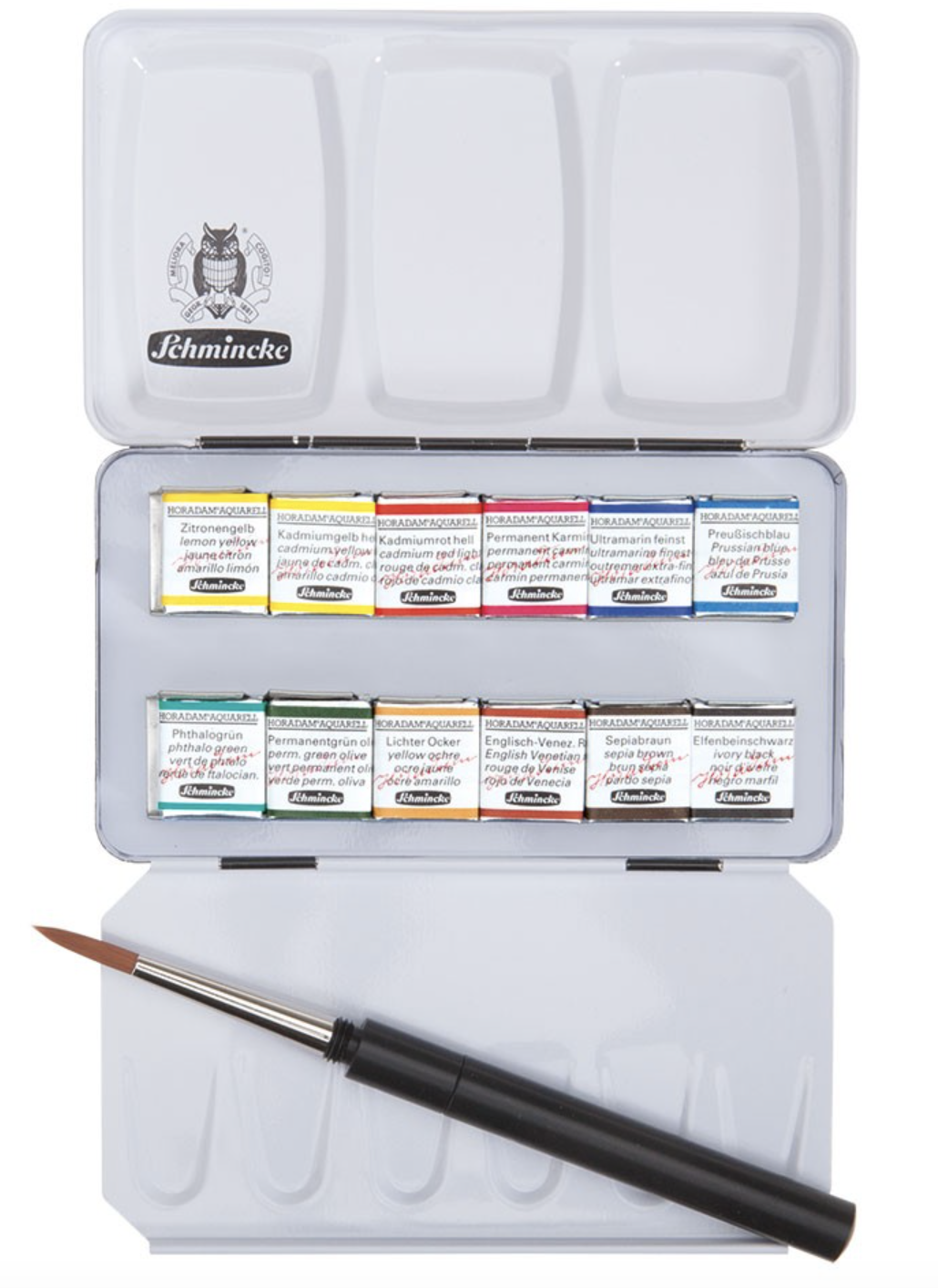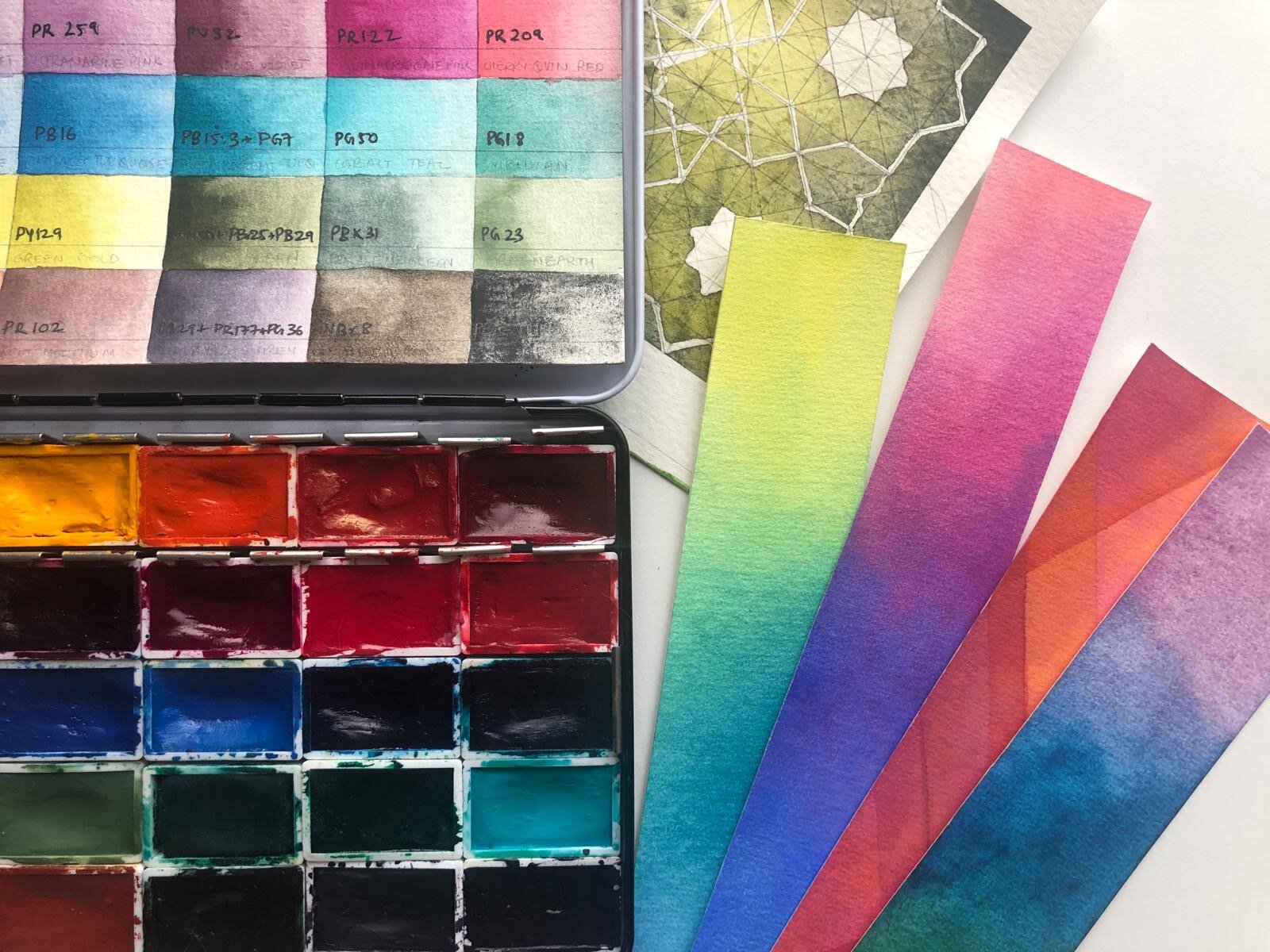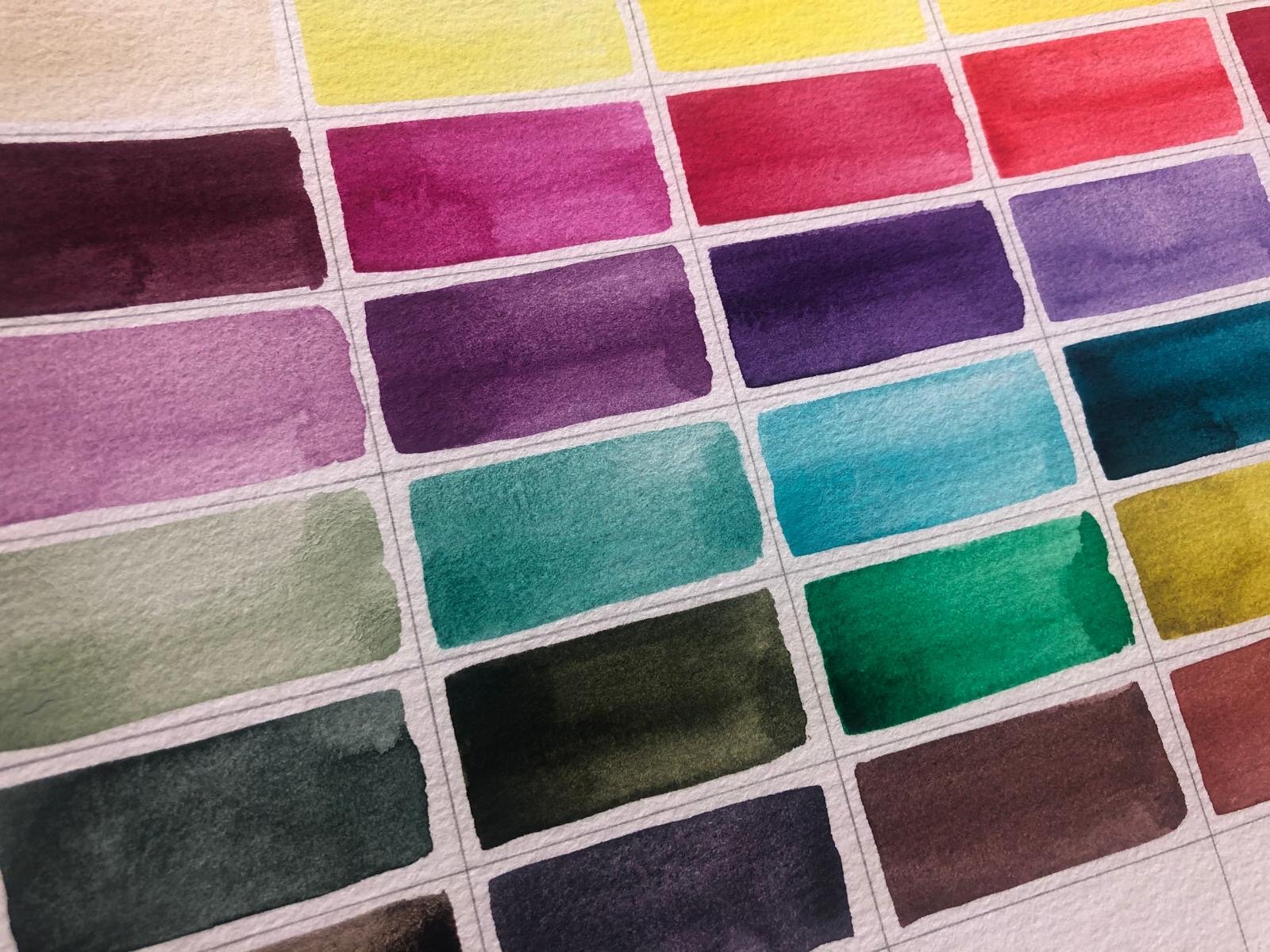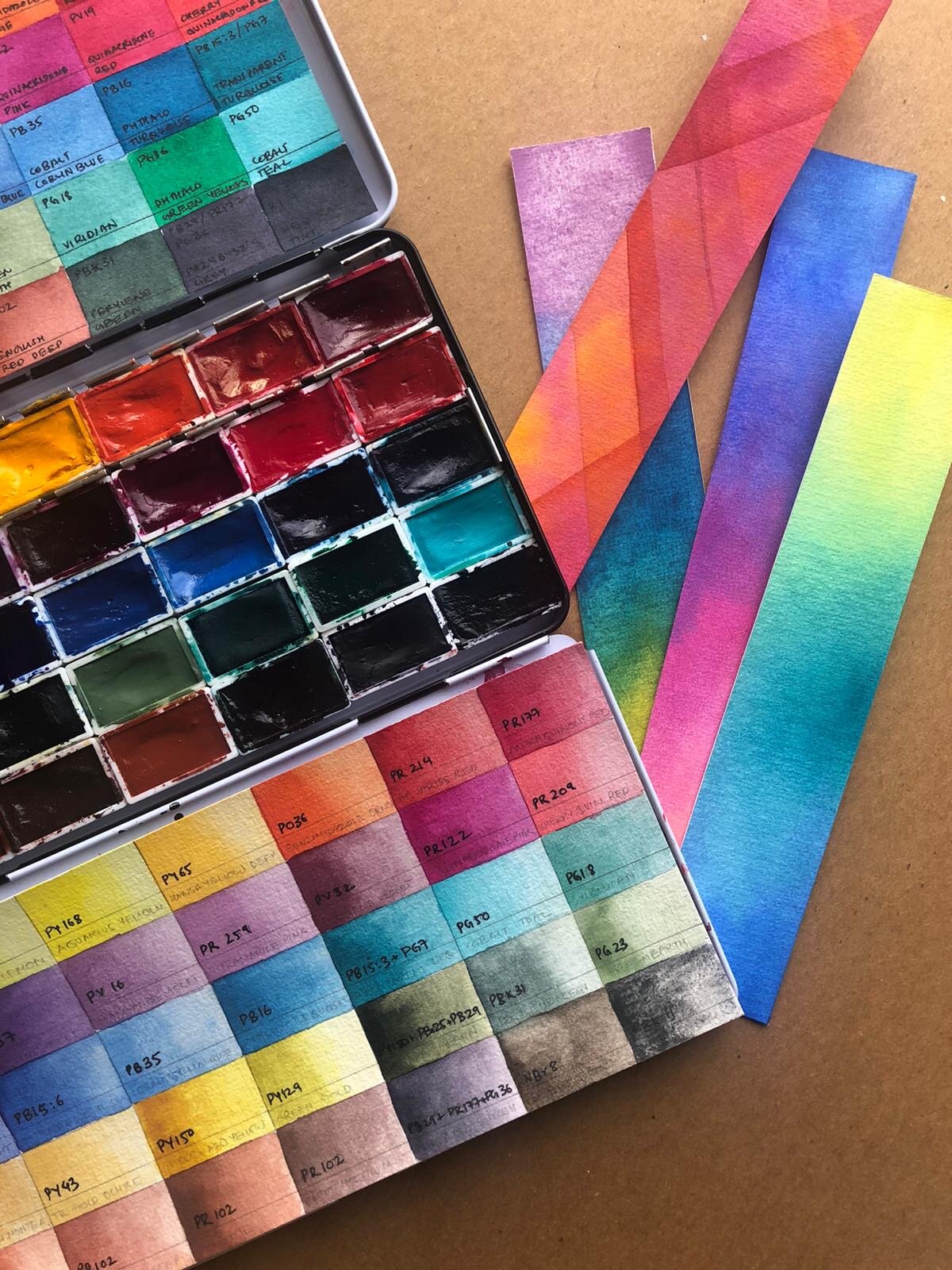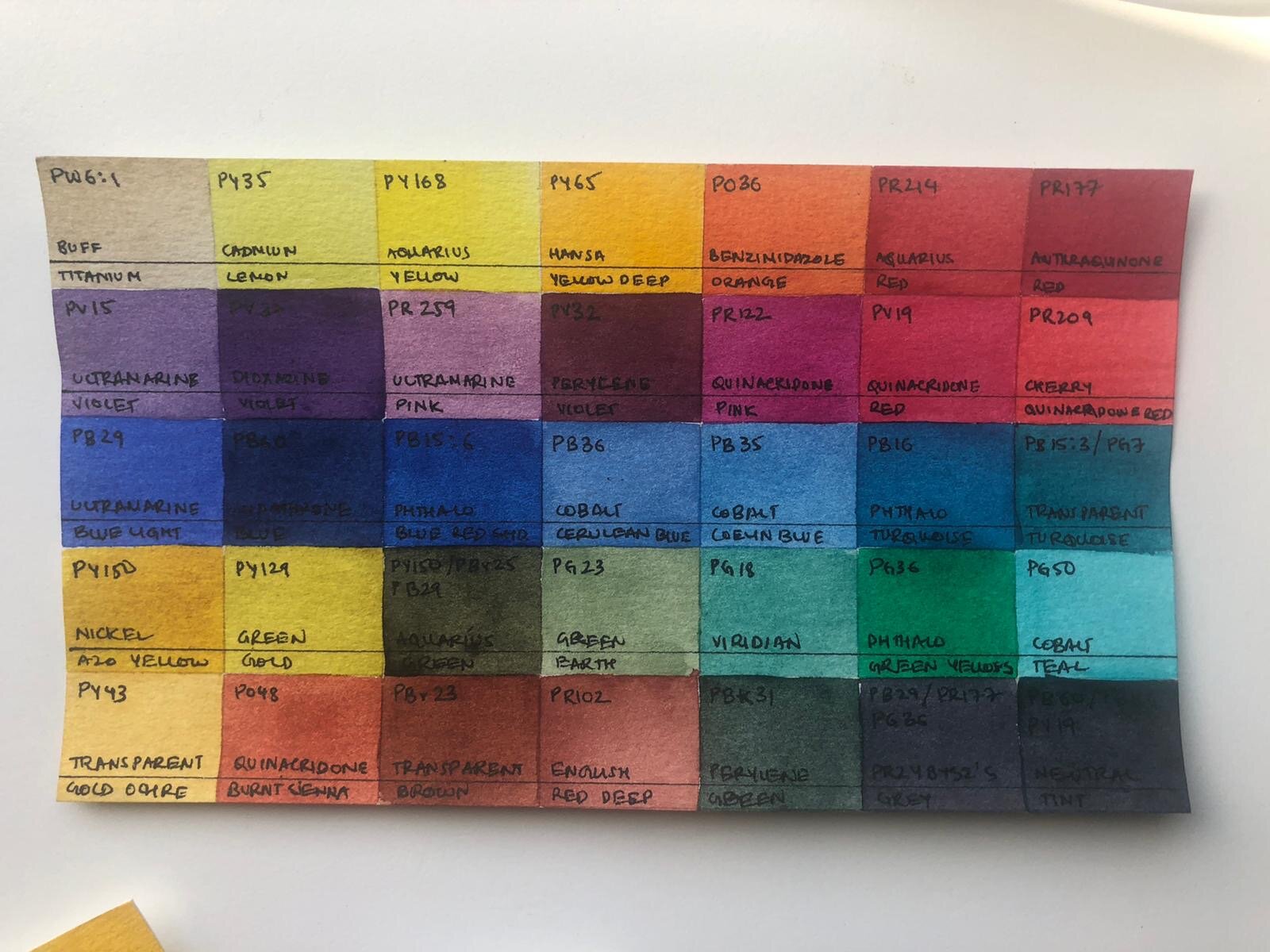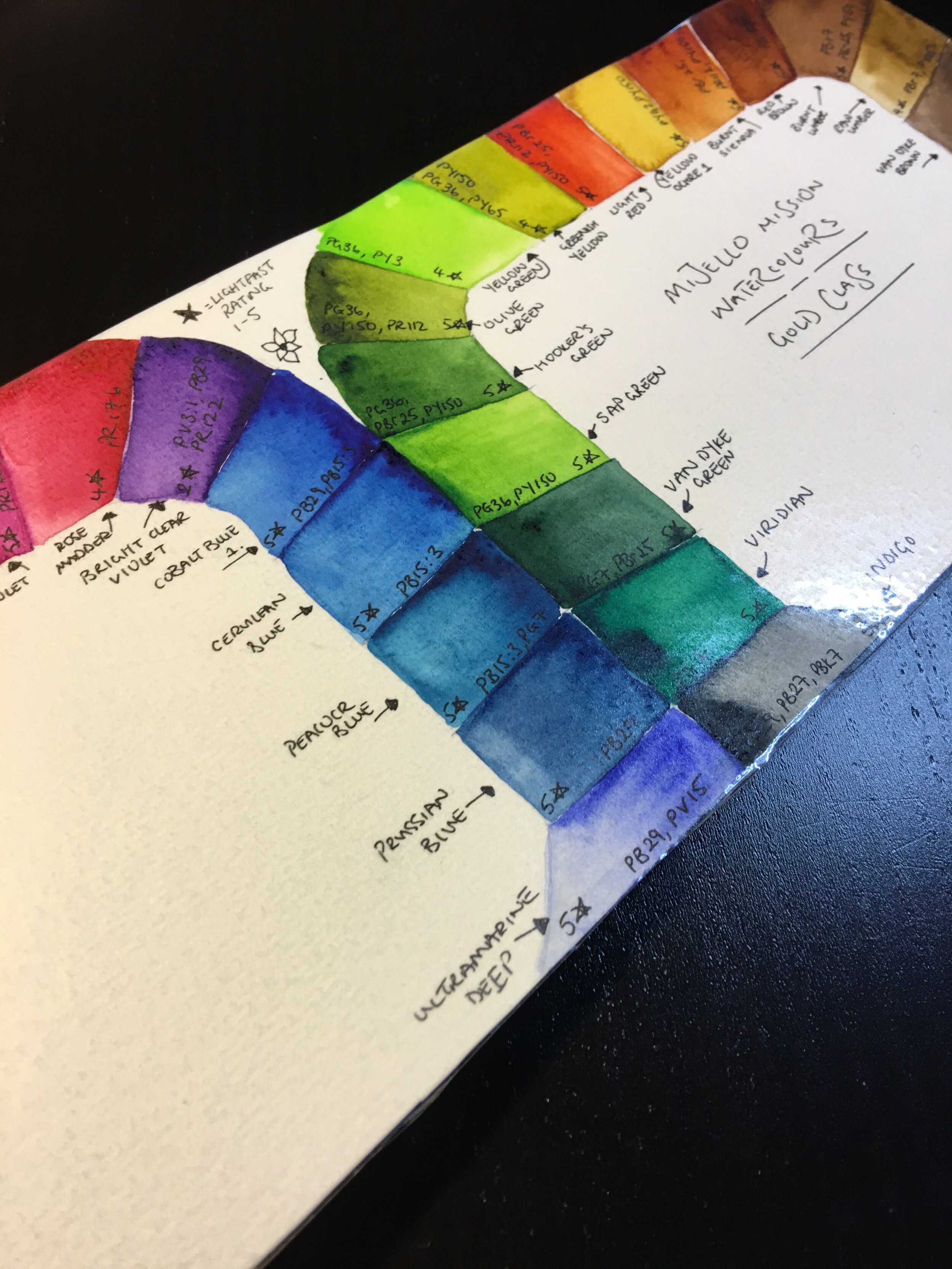Disclosure: This post may contain affiliate links, which means I may receive a small commission if you decide to make a purchase through my links at no extra cost to you.
At the end of 2019, I asked my Instagram followers what they wanted me to Blog about in 2020 and the overwhelming response I got was “Geometry and Watercolour”.
Well, its now June, we are a couple of months into the Corona virus lockdown and high time I got started…
So after a little thought and given there are already lots of free geometry resources available, I thought I would start by taking a look at getting started with watercolour!
This post will focus on paint and paper and will include some of my recommendations. If this is of interest read on! If not then we will see you next time :-)
Paint
Choosing your first watercolour paints can be a fairly daunting task as there are so many options available on the market and the pressure of getting it right first time can be a little overwhelming!
Figuring out what will work best for you will come with experience and a bit of trial and error, but I will try and cover some of the options available and give you some of my favourite recommendations.
Traditionally watercolour paint comes in either pans or tubes, but is also available in liquid form, as markers or crayons and of course there is the option of buying powdered pigment and making your own watercolours!
This post will focus on commercially available pans and tubes but if you are interested in making your own paints check my previous post where I talk about making my own pigments.
Pans
Most watercolour pans typically come in 2 sizes, ‘Half Pans’ or ‘Full Pans’. As the name suggests full pans hold twice as much paint as a half pan. Pans can be incredibly versatile as they can easily be moved between different sets and are very portable!
1. Half pans from Winsor & Newton
The paint in watercolour pans is either ‘poured’ or ‘extruded’. Poured paint is simply decanted into empty pans, and allowed to dry. The poured paint dries over several days or weeks and usually shrinks as the water evaporates. This process is repeated until the pan is full and completely dry.
Extruded paints are made with special machinery which compresses the paint before it is cut into little cakes which are then slotted into the pans.
TUBES
Tube paint is simply wet paint that has been poured into a tube. Tubes come in a range of sizes, but most brands have a smaller and larger size option, with the popular colours coming in the larger sized options.
2. Various brands of tube paint
I use both tubes and pans, but when buying individual colours I always opt for tubes as I then have the option of pouring it into a pan at home or using it directly from the tube.
3. A tube of Schmincke Horadam paint
Understanding your paint
Have you ever bought watercolour paint before and noticed the strange numbers and symbols printed on the sides of the tubes or wrappers? The first time I bought paint I had no idea what the information was telling me, but with time, learning to read and understand this information really helped me to learn how my watercolours would behave and what effects I could achieve with them.
In image 3, we see a tube of Turner’s Yellow paint from Schmincke Horadam. The tube has various symbols printed on it, including small black stars, a small black triangle and a half shaded square. What do they all mean?
In this case, the 4 stars are telling us that this paint has good light fastness (it won’t fade). The small black triangle tells us that this pigment is a staining colour (so it won’t be easy or possible to lift it) and the half shaded square is telling us that this paint is semi-opaque (so not ideal for glazing effects).
The info printed on the tube also tells us what pigments are used to manufacture the colour (although the pigment info isn’t visible in this image) - Pigment information is particularly helpful to have when we are mixing colours, but more of that in the future!
If you are interested in learning more about these mysterious symbols, let me know in the comments below and look out for a future post where I do a bit more of a deep dive into understanding your paint!
Watercolour sets
Buying a watercolour set is usually not bad idea for a beginner, because most of the thinking has been done for you! Sets come in a range of sizes, quality and cost. What I love about them is that they typically come in a lovely presentation tin that will double up as your palette. This also makes them highly portable which means you can take them anywhere. Here are a few of my favourites…
Winsor and Newton Professional Watercolour, Sketchers Box Set, 24 Half Pans
I absolutely love this set; it has 24 gorgeous professional quality half pans, which last and last. This is one of the real benefits of paying for professional (or Artist’s Grade) paint. The colours are rich and intense because they have more pigment in them and so small amounts go a very long way! This also happens to be the first set I bought about 6 years ago and it is still going strong!
This is the set I usually travel with, this was painted by the coast in Egypt a few summers ago!
Shop around before you by though, as prices can vary and there are often real bargains to be had. I got my set from Cass Art in the UK for a great price - so check out the links below if this set appeals to you!
Schmincke horadam - Watercolour Paint, 12 half pans
Small but mighty, this set comes with everything you need to start mixing and painting with your own unique colour palettes.
This is another professional quality set, but note that Schmincke also produce a mid/ student quality range which may be more suitable for your budget (Look out for Schmincke AKADEMIE Aquarelle if you want more information on their student range) - I have added a link to the Akademie set on Amazon below.
The set has 12 half pans, including a set of split primaries (a warm and cool shade of red, blue and yellow), which is the perfect starting point for creating a huge range of vibrant colours. You also get 6 additional colours including greens, earth tones and a black.
One of the best things about buying paint from Schmincke Horadam is that the paint in their pans is exactly the same as the paint in their tubes - so you know their pans and tubes will always give you the exact same results (this isn’t true for many other brands of commercial paint).
Roman Szmal - Recommended by artist Aziza Iqbal
So, in the process of putting this blog post together, I ended up chatting about my choices and recommendations with my watercolour partner in crime Aziza Iqbal (aka @Azizaesque). That conversation led directly to the inclusion of Roman Szmal in this list, and onto my own wish-list!
If you are looking for a set at a lower price point, Aziza highly recommends the options available from Roman Szmal. The paints come in sets of different sizes or as individual full size pans which are intensely pigmented and a dream to use. They also have a huge range of 140 colours so plenty of hues to choose from!
But don’t just take my word for it, or Aziza’s!
I would suggest you do your own research too. There are dozens of you tube channels which cover watercolour reviews and I would strongly suggest watching a few before you make any decisions!
The images and artwork directly above have all been provided by Aziza Iqbal and were painted by her using Roman Szmal paints.
To check out more of Aziza’s work - please visit her website at www.azizaiqbal.com

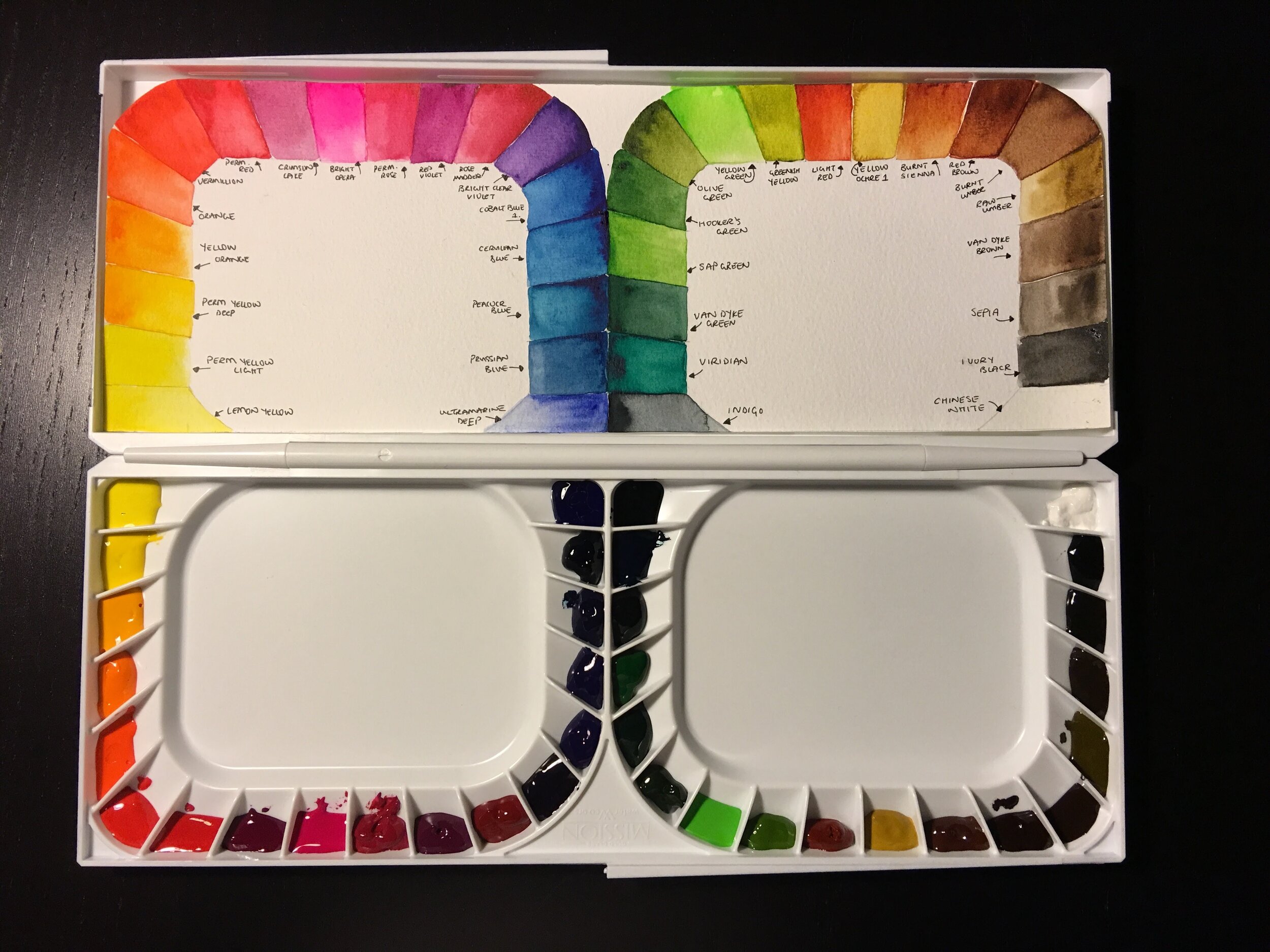
Mijello Mission Gold Sets
If mixing paints isn’t your thing; and convenience is more important then I’d suggest you take a look at the Mijello Mission Gold range. These also come as tube sets, but usually come with large empty palettes with plenty of space for you to squeeze out the paint and make up your own palette. The Mijello tubes are a generous 7 ml size and there is enough paint to last many years. The colours are incredibly intense and very easy to rewet and bring to life once they have dried and hardened in the palette.
Individual Pans or Tubes
The main alternative to paint sets is selecting and buying individual tubes or pans and building your very own bespoke collection of colour. I am a huge fan of this approach because I love variety and this allows me to try as many unique brands as I can, but it isn’t without its dangers. Check out my lists of pros and cons below; and decide for yourself.
PROs:
You get exactly what you want and don’t end up with colours that you will never use
You get to pick and choose from different brands and are not tied down to any single one
You can buy either tubes or pans or both!
If you end up buying a colour or brand that you don’t like, you haven’t lost too much money!
You can create endless bespoke palettes
You can buy paint from artisanal paint makers - and support other creatives
Lots of professional grade paint manufacturers produce dot charts, (paper sheets with dots of paint on them, so you can try before you buy)
CONs
Unless you are very disciplined (unlike me) buying individual colours can get pretty expensive
It can be VERY difficult to choose a handful of colours when you are faced with literally thousands of individual options (trust me I have spent hours staring at colour charts!)
Its really easy to end up buying the same hues from different manufacturers as the printed colour charts can look quite different but in reality the paint is almost identical
With pan sets you end up using a range of colours that you may not otherwise try if you had to buy them individually - I have discovered some lovely shades because they were already in the sets that I bought
Unless you have a strong understanding of colour mixing theory, you may end up buying colours that you can mix yourself or you could end up with colours that don’t mix well or compliment each other.
Recommendations
For individual colours, my favourite brands include:
PAPER
I’m not going to say a huge amount about watercolour paper here, because I have a very detailed post about it which you can find here, but for ease I will say the following and include my favourite paper recommendations below:
Buy the best paper you can afford! I would much rather use student grade paint with high quality paper rather than professional quality paint with cheaper / student grade paper. Good quality paper allows you to do so much more than you realise and really is worth the investment!
MY RECOMMENDATIONS:
For fine work like manuscript illumination or pieces where I want to use shell gold (where a smooth surface helps the gold to really shine) I almost always use Fabriano Artistico Hot Press Watercolour paper - 300 gsm, which I buy in blocks and in loose sheets.
If I want to do a more expressive watercolour I use Arches Aquarelle Cold Press - 300 gsm . I usually buy blocks or individual sheets which I cut down to the size I want. I also love working on natural hand made khadi papers, but these can be challenging to work with because they have almost too much sizing sometimes!
Another more recent favourite is another pure cotton paper, made by Saunders Waterford. I buy loose sheets, and use a heavier weight. Note these papers come in different shades of white so check all the options before you decide!
I also really like the Daler Rowney Langton range in both hot and cold press which is a little more affordable than both the Arches and Fabriano.
For practise papers, I like the Daler Rowney student ranges or even the own brands from shops like Cass Art. The main thing to remember is to always buy paper that is acid free.
So there you have it! I hope you found the information helpful. If you have any questions leave me a comment below and I will do my best to get back to you!
If you have personal favourites or other watercolour recommendations that I haven’t mentioned leave a comment as I would love to hear about them 🙂

